Nickel Cobaltite Functionalized Silver Doped Carbon Xerogels as Efficient Electrode Materials for High Performance Symmetric Supercapacitor
Abstract
1. Introduction
2. Materials and Methods
2.1. Materials
2.2. Preparation of Porous Carbon Xerogel (CX)
2.3. Preparation of Silver Doped Carbon Xerogel (Ag-CX)
2.4. NiCo2O4 Functionalization of Ag-CX (NiCo2O4/Ag-CX)
2.5. Structural Characterization
2.6. Preparation of Symmetric Hybrid Device and Electrochemical Measurement
3. Results and Discussions
3.1. Physicochemical Characteristics
3.2. Electrochemical Study
4. Conclusions
Author Contributions
Funding
Conflicts of Interest
References
- Libich, J.; Máca, J.; Vondrák, J.; Čech, O.; Sedlaříková, M. Supercapacitors: Properties and applications. J. Energy Storage 2018, 17, 224–227. [Google Scholar] [CrossRef]
- González, A.; Goikolea, E.; Barrena, J.A.; Mysyk, R. Review on supercapacitors: Technologies and materials. Renew. Sustain. Energy Rev. 2016, 58, 1189–1206. [Google Scholar] [CrossRef]
- Amouroux, J.; Siffert, P.; Pierre Massué, J.; Cavadias, S.; Trujillo, B.; Hashimoto, K.; Rutberg, P.; Dresvin, S.; Wang, X. Carbon dioxide: A new material for energy storage. Prog. Nat. Sci. Mater. Int. 2014, 24, 295–304. [Google Scholar] [CrossRef]
- Maroušek, J.; Strunecký, O.; Kolář, L.; Vochozka, M.; Kopecký, M.; Maroušková, A.; Batt, J.; Poliak, M.; Šoch, M.; Bartoš, P.; et al. Advances in nutrient management make it possible to accelerate biogas production and thus improve the economy of food waste processing. Energy SourcesPart A RecoveryUtil. Environ. Eff. 2020, 1–10. [Google Scholar] [CrossRef]
- Maroušek, J.; Strunecký, O.; Stehel, V. Biochar farming: Defining economically perspective applications. Clean Technol. Environ. Policy 2019, 21, 1389–1395. [Google Scholar] [CrossRef]
- Sharma, K.; Arora, A.; Tripathi, S.K. Review of supercapacitors: Materials and devices. J. Energy Storage 2019, 21, 801–825. [Google Scholar] [CrossRef]
- Li, H.; He, X.; Kang, Z.; Huang, H.; Liu, Y.; Liu, J.; Lian, S.; Tsang, C.H.A.; Yang, X.; Lee, S.T.J.A.C. Water-soluble fluorescent carbon quantum dots and photocatalyst design. Angew. Chem. 2010, 122, 4532–4536. [Google Scholar] [CrossRef]
- Simon, P.; Gogotsi, Y. Materials for electrochemical capacitors. Nat. Mater. 2008, 7, 845. [Google Scholar] [CrossRef]
- Nishino, A.; Yoshida, A.; Tanahashi, I. Electric Double Layer Capacitor. US4562511A 1985.
- Winter, M.; Brodd, R.J. What are batteries, fuel cells, and supercapacitors? Chem. Rev. 2004, 104, 4245–4270. [Google Scholar] [CrossRef]
- Zhi, M.; Xiang, C.; Li, J.; Li, M.; Wu, N. Nanostructured carbon–metal oxide composite electrodes for supercapacitors: A review. Nanoscale 2013, 5, 72–88. [Google Scholar] [CrossRef]
- Frackowiak, E. Carbon materials for supercapacitor application. Phys. Chem. Chem. Phys. 2007, 9, 1774–1785. [Google Scholar] [CrossRef]
- Ma, J.; Guo, Q.; Gao, H.-L.; Qin, X. Synthesis of C60/Graphene Composite as Electrode in Supercapacitors. Fuller. Nanotub. Carbon Nanostructures 2015, 23, 477–482. [Google Scholar] [CrossRef]
- Abdelwahab, A.; Castelo-Quibén, J.; Pérez-Cadenas, M.; Maldonado-Hódar, F.J.; Carrasco-Marín, F.; Pérez-Cadenas, A.F. Insight of the effect of graphitic cluster in the performance of carbon aerogels doped with nickel as electrodes for supercapacitors. Carbon 2018, 139, 888–895. [Google Scholar] [CrossRef]
- Dubey, R.; Guruviah, V. Review of carbon-based electrode materials for supercapacitor energy storage. Ionics 2019, 25, 1419–1445. [Google Scholar] [CrossRef]
- Pandolfo, A.G.; Hollenkamp, A.F. Carbon properties and their role in supercapacitors. J. Power Sources 2006, 157, 11–27. [Google Scholar] [CrossRef]
- Merino, C.; Soto, P.; Vilaplana-Ortego, E.; Gomez de Salazar, J.M.; Pico, F.; Rojo, J.M. Carbon nanofibres and activated carbon nanofibres as electrodes in supercapacitors. Carbon 2005, 43, 551–557. [Google Scholar] [CrossRef]
- Frackowiak, E.; Jurewicz, K.; Szostak, K.; Delpeux, S.; Béguin, F. Nanotubular materials as electrodes for supercapacitors. Fuel Process. Technol. 2002, 77–78, 213–219. [Google Scholar] [CrossRef]
- Frackowiak, E.; Delpeux, S.; Jurewicz, K.; Szostak, K.; Cazorla-Amoros, D.; Béguin, F. Enhanced capacitance of carbon nanotubes through chemical activation. Chem. Phys. Lett. 2002, 361, 35–41. [Google Scholar] [CrossRef]
- Li, F.; Xie, L.; Sun, G.; Kong, Q.; Su, F.; Cao, Y.; Wei, J.; Ahmad, A.; Guo, X.; Chen, C.-M. Resorcinol-formaldehyde based carbon aerogel: Preparation, structure and applications in energy storage devices. Microporous Mesoporous Mater. 2019, 279, 293–315. [Google Scholar] [CrossRef]
- Zapata-Benabithe, Z.; Carrasco-Marín, F.; Moreno-Castilla, C. Electrochemical performance of Cu- and Ag-doped carbon aerogels. Mater. Chem. Phys. 2013, 138, 870–876. [Google Scholar] [CrossRef]
- Liu, X.; Li, S.; Mi, R.; Mei, J.; Liu, L.-M.; Cao, L.; Lau, W.-M.; Liu, H. Porous structure design of carbon xerogels for advanced supercapacitor. Appl. Energy 2015, 153, 32–40. [Google Scholar] [CrossRef]
- Zhang, Y.; Li, L.; Su, H.; Huang, W.; Dong, X. Binary metal oxide: Advanced energy storage materials in supercapacitors. J. Mater. Chem. A 2015, 3, 43–59. [Google Scholar] [CrossRef]
- Xie, J.; Sun, X.; Zhang, N.; Xu, K.; Zhou, M.; Xie, Y. Layer-by-layer β-Ni(OH)2/graphene nanohybrids for ultraflexible all-solid-state thin-film supercapacitors with high electrochemical performance. Nano Energy 2013, 2, 65–74. [Google Scholar] [CrossRef]
- Eskandari, M.; Malekfar, R.; Buceta, D.; Taboada, P. NiCo2O4-based nanostructured composites for high-performance pseudocapacitor electrodes. Colloids Surf. A Physicochem. Eng. Asp. 2020, 584, 124039. [Google Scholar] [CrossRef]
- Nan, J.; Shi, Y.; Xiang, Z.; Wang, S.; Yang, J.; Zhang, B. Ultrathin NiCo2O4 nanosheets assembled on biomass-derived carbon microsheets with polydopamine for high-performance hybrid supercapacitors. Electrochim. Acta 2019, 301, 107–116. [Google Scholar] [CrossRef]
- Oh, K.H.; Gund, G.S.; Park, H.S. Stabilizing NiCo2O4 hybrid architectures by reduced graphene oxide interlayers for improved cycling stability of hybrid supercapacitors. J. Mater. Chem. A 2018, 6, 22106–22114. [Google Scholar] [CrossRef]
- Qi, X.; Zheng, W.; He, G.; Tian, T.; Du, N.; Wang, L. NiCo2O4 hollow microspheres with tunable numbers and thickness of shell for supercapacitors. Chem. Eng. J. 2017, 309, 426–434. [Google Scholar] [CrossRef]
- Marichi, R.B.; Goel, S.; Tomar, A.K.; Sahu, V.; Lalwani, S.; Singh, G.; Sharma, R.K. Direct hydrothermal treatment of sugarcane juice for 3D oxygen-rich carbon Aerogel/NiCo2O4 based supercapacitor. Mater. Chem. Phys. 2020, 239, 121957. [Google Scholar] [CrossRef]
- El-Deeb, M.M.; El Rouby, W.M.A.; Abdelwahab, A.; Farghali, A.A. Effect of pore geometry on the electrocatalytic performance of nickel cobaltite/carbon xerogel nanocomposite for methanol oxidation. Electrochim. Acta 2018, 259, 77–85. [Google Scholar] [CrossRef]
- Lufrano, F.; Staiti, P.; Calvo, E.G.; Juárez-Pérez, E.J.; Menéndez, J.A.; Arenillas, A. Carbon xerogel and manganese oxide capacitive materials for advanced supercapacitors. Int. J. Electrochem. Sci. 2011, 6, 596–612. [Google Scholar]
- Matthias, T.; Katsumi, K.; Alexander, V.N.; James, P.O.; Francisco, R.-R.; Jean, R.; Kenneth, S.W.S. Physisorption of gases, with special reference to the evaluation of surface area and pore size distribution (IUPAC Technical Report). Pure Appl. Chem. 2015, 87, 1051–1069. [Google Scholar]
- Obata, K.; Doi, A.; Nishibori, M.; Shimanoe, K.; Suzuki, T.; Matsushima, S. Morphology, microstructure, and surface area of La-added MgFe2O4 powder. J. Ceram. Soc. Jpn. 2018, 126, 402–407. [Google Scholar] [CrossRef]
- Prakash, P.; Gnanaprakasam, P.; Emmanuel, R.; Arokiyaraj, S.; Saravanan, M. Green synthesis of silver nanoparticles from leaf extract of Mimusops elengi, Linn. for enhanced antibacterial activity against multi drug resistant clinical isolates. Colloids Surf. B Biointerfaces 2013, 108, 255–259. [Google Scholar] [CrossRef] [PubMed]
- Umeshbabu, E.; Ranga Rao, G. NiCo2O4 hexagonal nanoplates anchored on reduced graphene oxide sheets with enhanced electrocatalytic activity and stability for methanol and water oxidation. Electrochim. Acta 2016, 213, 717–729. [Google Scholar] [CrossRef]
- Masa, J.; Zhao, A.; Xia, W.; Muhler, M.; Schuhmann, W. Metal-free catalysts for oxygen reduction in alkaline electrolytes: Influence of the presence of Co, Fe, Mn and Ni inclusions. Electrochim. Acta 2014, 128, 271–278. [Google Scholar] [CrossRef]
- Wang, J.; Wu, Z.; Han, L.; Lin, R.; Xin, H.L.; Wang, D. Hollow-Structured Carbon-Supported Nickel Cobaltite Nanoparticles as an Efficient Bifunctional Electrocatalyst for the Oxygen Reduction and Evolution Reactions. ChemCatChem 2016, 8, 736–742. [Google Scholar] [CrossRef]
- Wee, G.; Mak, W.F.; Phonthammachai, N.; Kiebele, A.; Reddy, M.V.; Chowdari, B.V.R.; Gruner, G.; Srinivasan, M.; Mhaisalkar, S.G. Particle Size Effect of Silver Nanoparticles Decorated Single Walled Carbon Nanotube Electrode for Supercapacitors. J. Electrochem. Soc. 2010, 157, A179. [Google Scholar] [CrossRef]
- Abdelwahab, A.; Castelo-Quibén, J.; Pérez-Cadenas, M.; Elmouwahidi, A.; Maldonado-Hódar, F.J.; Carrasco-Marín, F.; Pérez-Cadenas, A.F. Cobalt-Doped Carbon Gels as Electro-Catalysts for the Reduction of CO2 to Hydrocarbons. Catalysts 2017, 7, 25. [Google Scholar] [CrossRef]
- Long, C.; Jiang, L.; Wu, X.; Jiang, Y.; Yang, D.; Wang, C.; Wei, T.; Fan, Z. Facile synthesis of functionalized porous carbon with three-dimensional interconnected pore structure for high volumetric performance supercapacitors. Carbon 2015, 93, 412–420. [Google Scholar] [CrossRef]
- Stoller, M.D.; Ruoff, R.S. Best practice methods for determining an electrode material’s performance for ultracapacitors. Energy Environ. Sci. 2010, 3, 1294–1301. [Google Scholar] [CrossRef]
- Alamin, A.A.; Abd Elhamid, A.E.M.; Anis, W.R.; Attiya, A.M. Fabrication of symmetric supercapacitor based on relatively long lifetime polyaniline grown on reduced graphene oxide via Fe2+ oxidation sites. Diam. Relat. Mater. 2019, 96, 182–194. [Google Scholar] [CrossRef]
- Wang, X.; Han, X.; Lim, M.; Singh, N.; Gan, C.L.; Jan, M.; Lee, P.S. Nickel Cobalt Oxide-Single Wall Carbon Nanotube Composite Material for Superior Cycling Stability and High-Performance Supercapacitor Application. J. Phys. Chem. C 2012, 116, 12448–12454. [Google Scholar] [CrossRef]
- Rennie, A.J.R.; Martins, V.L.; Smith, R.M.; Hall, P.J. Influence of Particle Size Distribution on the Performance of Ionic Liquid-based Electrochemical Double Layer Capacitors. Sci. Rep. 2016, 6, 22062. [Google Scholar] [CrossRef]
- Pilban Jahromi, S.; Pandikumar, A.; Goh, B.T.; Lim, Y.S.; Basirun, W.J.; Lim, H.N.; Huang, N.M. Influence of particle size on performance of a nickel oxide nanoparticle-based supercapacitor. RSC Adv. 2015, 5, 14010–14019. [Google Scholar] [CrossRef]
- Singh, A.; Ojha, S.K.; Ojha, A.K. Facile synthesis of porous nanostructures of NiCo2O4 grown on rGO sheet for high performance supercapacitors. Synth. Met. 2020, 259, 116215. [Google Scholar] [CrossRef]
- Hao, P.; Tian, J.; Sang, Y.; Tuan, C.-C.; Cui, G.; Shi, X.; Wong, C.P.; Tang, B.; Liu, H. 1D Ni–Co oxide and sulfide nanoarray/carbon aerogel hybrid nanostructures for asymmetric supercapacitors with high energy density and excellent cycling stability. Nanoscale 2016, 8, 16292–16301. [Google Scholar] [CrossRef]
- Wang, Z.; Zhang, X.; Zhang, Z.; Qiao, N.; Li, Y.; Hao, Z. Hybrids of NiCo2O4 nanorods and nanobundles with graphene as promising electrode materials for supercapacitors. J. Colloid Interface Sci. 2015, 460, 303–309. [Google Scholar] [CrossRef]
- Hao, P.; Zhao, Z.; Tian, J.; Li, H.; Sang, Y.; Yu, G.; Cai, H.; Liu, H.; Wong, C.P.; Umar, A. Hierarchical porous carbon aerogel derived from bagasse for high performance supercapacitor electrode. Nanoscale 2014, 6, 12120–12129. [Google Scholar] [CrossRef]
- Wang, Y.; Lei, Y.; Li, J.; Gu, L.; Yuan, H.; Xiao, D. Synthesis of 3D-Nanonet Hollow Structured Co3O4 for High Capacity Supercapacitor. ACS Appl. Mater. Interfaces 2014, 6, 6739–6747. [Google Scholar] [CrossRef]
- Dong, X.; Wang, X.; Wang, J.; Song, H.; Li, X.; Wang, L.; Chan-Park, M.B.; Li, C.M.; Chen, P. Synthesis of a MnO2–graphene foam hybrid with controlled MnO2 particle shape and its use as a supercapacitor electrode. Carbon 2012, 50, 4865–4870. [Google Scholar] [CrossRef]
- Kovacova, M.; Segers, C.; Tumpach, M.; Michalkova, L. Big Data-driven Smart Manufacturing: Sustainable Production Processes, Real-Time Sensor Networks, and Industrial Value Creation. Econ. Manag. Financ. Mark. 2020, 15, 54–60. [Google Scholar]
- Wang, H.; Wang, X. Growing Nickel Cobaltite Nanowires and Nanosheets on Carbon Cloth with Different Pseudocapacitive Performance. ACS Appl. Mater. Interfaces 2013, 5, 6255–6260. [Google Scholar] [CrossRef] [PubMed]
- Shahraki, M.; Elyasi, S.; Heydari, H.; Dalir, N. Synthesis of Carbon-Based Spinel NiCo2O4 Nanocomposite and Its Application as an Electrochemical Capacitor. J. Electron. Mater. 2017, 46, 4948–4954. [Google Scholar] [CrossRef]
- Ding, R.; Qi, L.; Jia, M.; Wang, H. Facile and large-scale chemical synthesis of highly porous secondary submicron/micron-sized NiCo2O4 materials for high-performance aqueous hybrid AC-NiCo2O4 electrochemical capacitors. Electrochim. Acta 2013, 107, 494–502. [Google Scholar] [CrossRef]

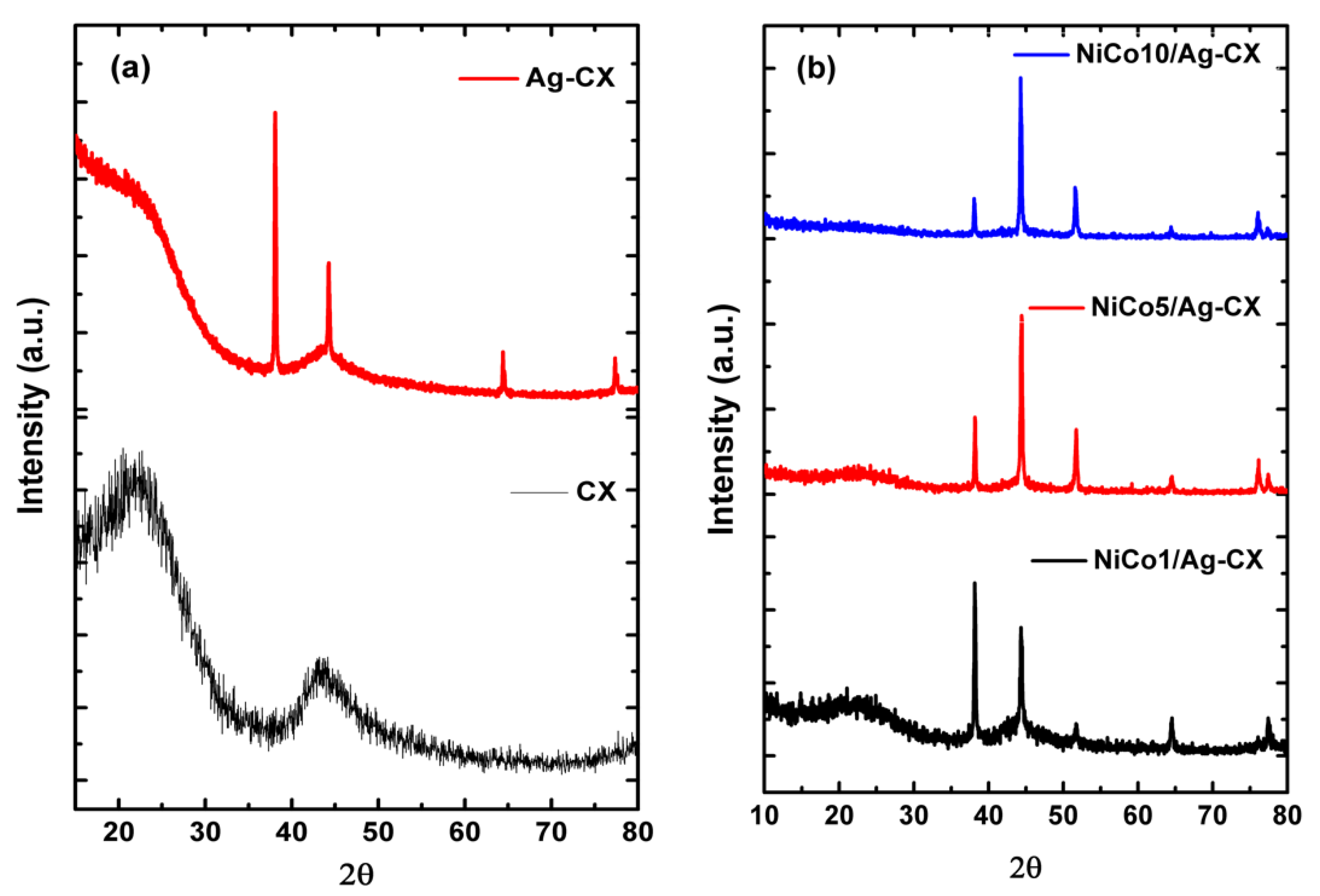
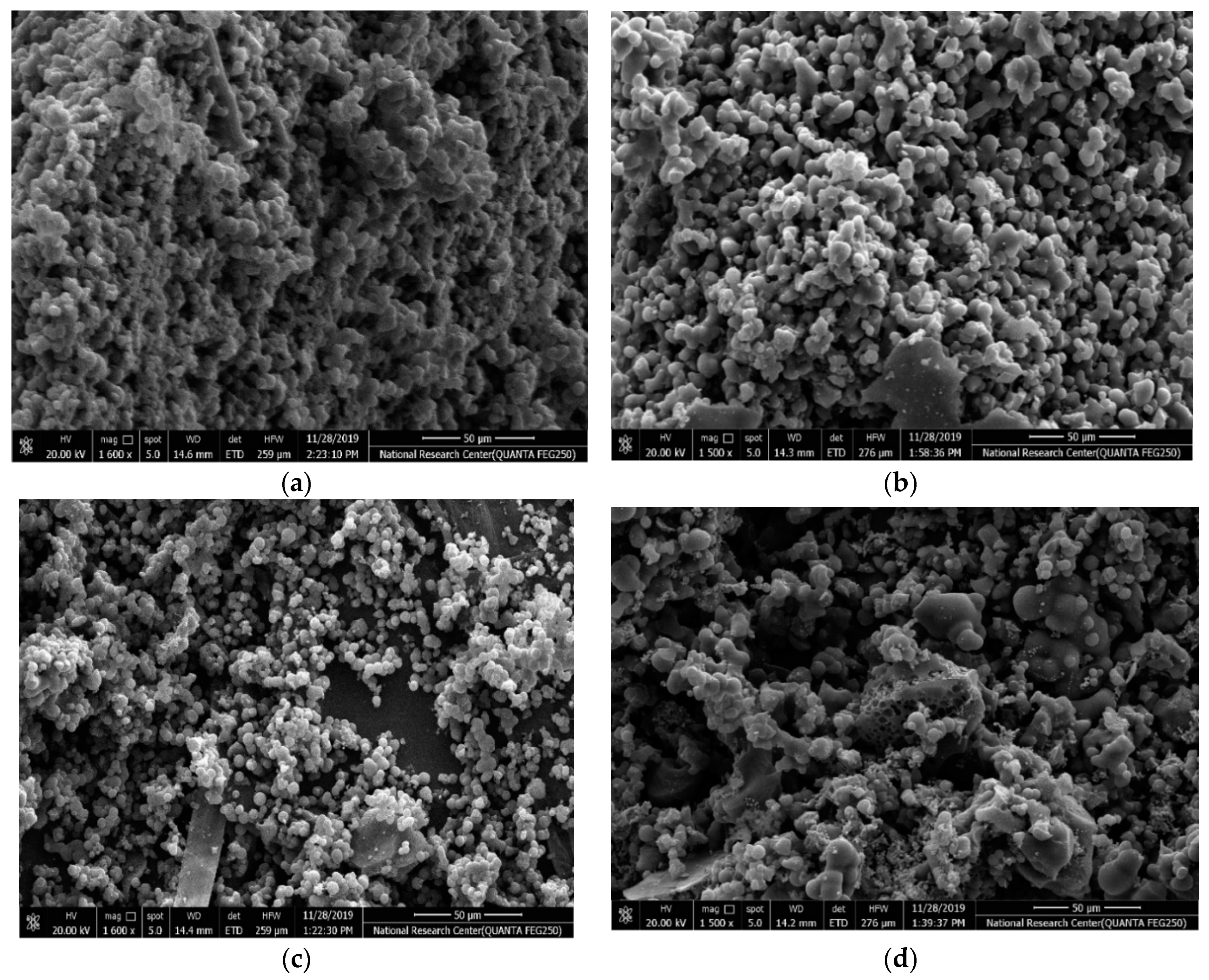
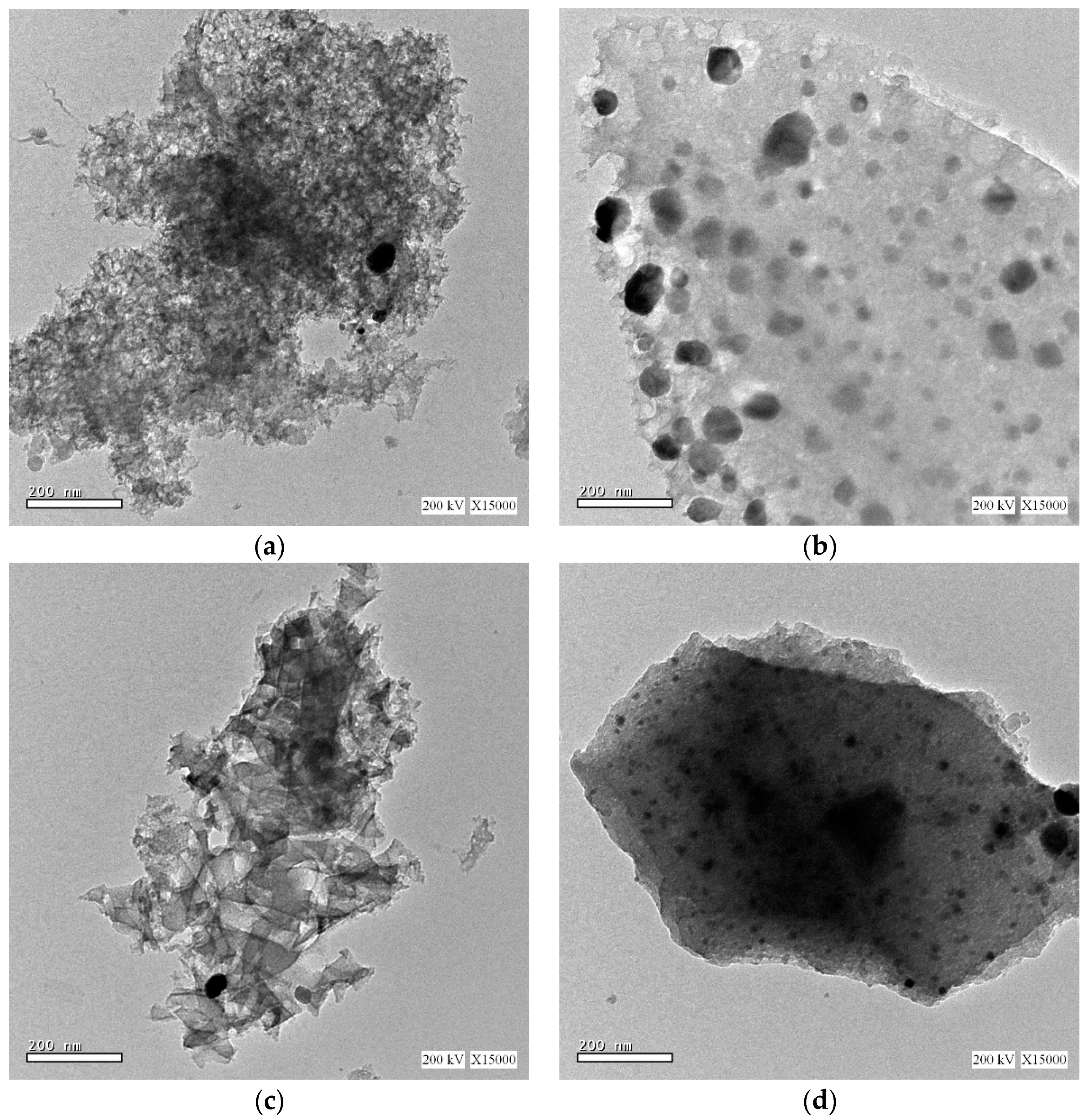
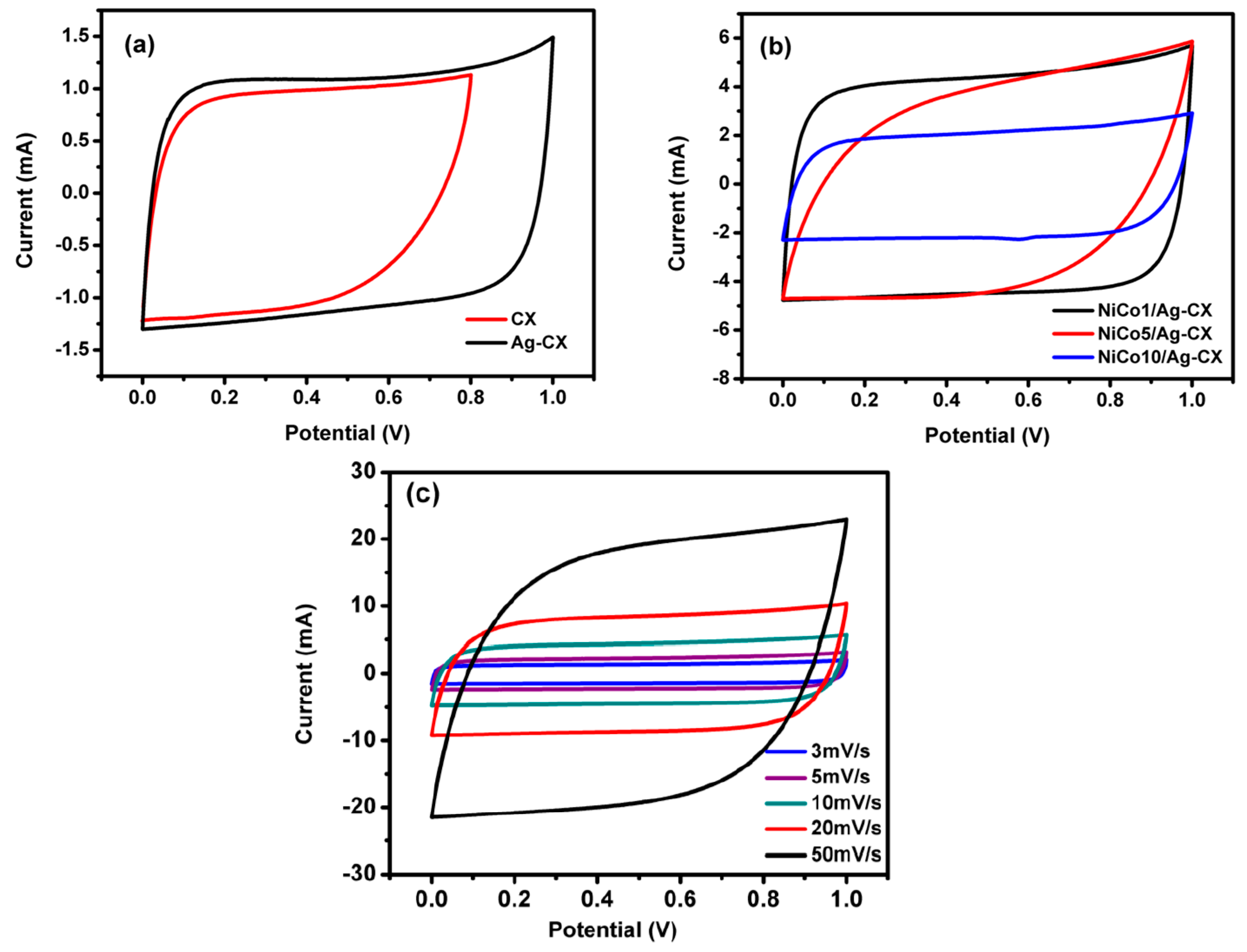

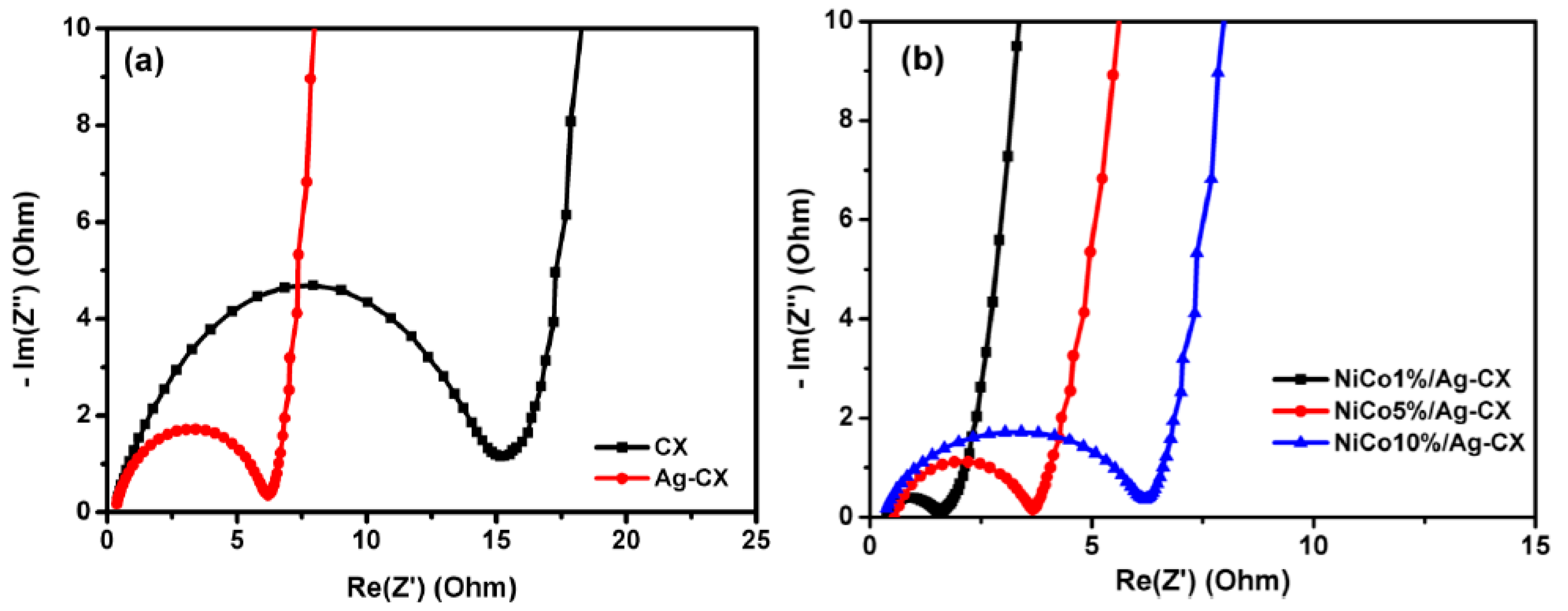
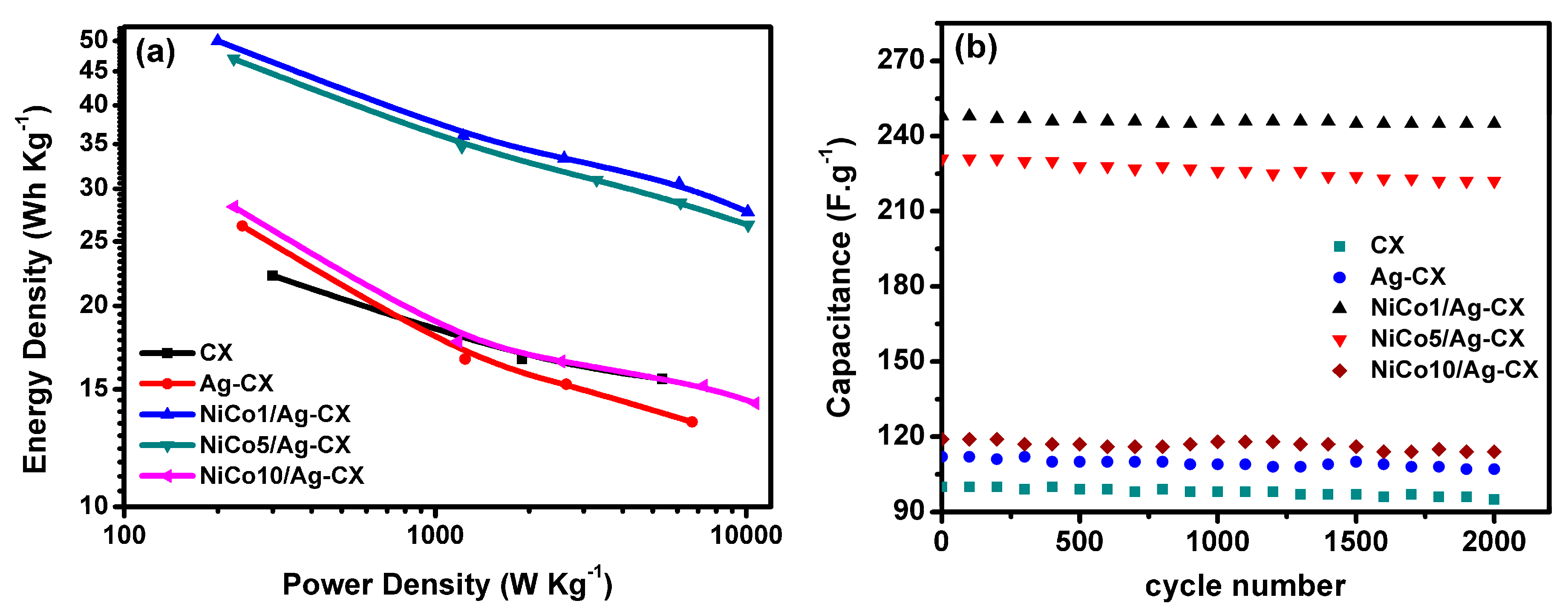
| Sample | SBET | W0(N2) | L0(N2) |
|---|---|---|---|
| m2/g | cm3/g | nm | |
| CX | 462 | 0.12 | 4.33 |
| Ag-CX | 590 | 0.24 | 0.86 |
| NiCo1/Ag-CX | 522 | 0.20 | 0.89 |
| NiCo5/Ag-CX | 811 | 0.32 | 1.00 |
| NiCo10/Ag-CX | 398 | 0.17 | 1.04 |
| Sample | dXRD (nm) |
|---|---|
| Ag-CX | 35.2 |
| NiCo1/Ag-CX | 26.7 |
| NiCo5/Ag-CX | 31.8 |
| NiCo10/Ag-CX | 30.9 |
| Samples | CV | Charge-Discharge | ESR | RCs | ||||
|---|---|---|---|---|---|---|---|---|
| C3mv/s | C5mv/s | C10mv/s | C0.1A/g | C0.5A/g | C1A/g | |||
| F·g−1 | F·g−1 | F·g−1 | F·g−1 | F·g−1 | F·g−1 | Ω | % | |
| CX | 119 | 100 | 92 | 160 | 124 | 112 | 16.5 | 95 |
| Ag-CX | 179 | 172 | 160 | 192 | 122 | 112 | 6.8 | 96 |
| NiCo1/Ag-CX | 372 | 360 | 342 | 368 | 270 | 248 | 1.9 | 99 |
| NiCo5/Ag-CX | 360 | 336 | 299 | 341 | 250 | 234 | 3.8 | 96 |
| NiCo10/Ag-CX | 180 | 179 | 163 | 203 | 128 | 119 | 6.4 | 96 |
| Sample | Electrolyte | Configuration | Cs | ED | PD | RCs | Reference |
|---|---|---|---|---|---|---|---|
| F·g−1 | Wh.kg−1 | KW.kg−1 | % | ||||
| NiCo2O4/carbon cloth | 1M KOH | *Three electrode | 245@1A.g−1 | - | - | 95 | [53] |
| CNT/NiCo2O4 | 6M KOH | *Three electrode | 210@2A.g−1 | - | - | 92 | [54] |
| NiCo2O4/CA | 2M KOH | Two electrode | 155@0.5A.g−1 | 47.5 | 0.4 | 97 | [47] |
| NiCo2O4/AC | 2M KOH | Two electrode | 74@1A.g−1 | 21.4 | 0.350 | 95 | [27] |
| AC-NiCo2O4 | 6M KOH | Two electrode | 54@0.5A.g−1 | 14.7 | 0.175 | 85 | [55] |
| carbon aerogel/NiCo2O4 | 6M KOH | Two electrode | 160@0.5 A.g−1 | 25 | 1.1085 | 98 | [29] |
| This work | 6M KOH | Two electrode | 270@0.5 A.g−1 | 50 | 0.2 | 99 | - |
Publisher’s Note: MDPI stays neutral with regard to jurisdictional claims in published maps and institutional affiliations. |
© 2020 by the authors. Licensee MDPI, Basel, Switzerland. This article is an open access article distributed under the terms and conditions of the Creative Commons Attribution (CC BY) license (http://creativecommons.org/licenses/by/4.0/).
Share and Cite
A. Wasfey, M.; Abdelwahab, A.; Carrasco-Marín, F.; Pérez-Cadenas, A.F.; H Abdullah, H.; S. Yahia, I.; Farghali, A.A. Nickel Cobaltite Functionalized Silver Doped Carbon Xerogels as Efficient Electrode Materials for High Performance Symmetric Supercapacitor. Materials 2020, 13, 4906. https://doi.org/10.3390/ma13214906
A. Wasfey M, Abdelwahab A, Carrasco-Marín F, Pérez-Cadenas AF, H Abdullah H, S. Yahia I, Farghali AA. Nickel Cobaltite Functionalized Silver Doped Carbon Xerogels as Efficient Electrode Materials for High Performance Symmetric Supercapacitor. Materials. 2020; 13(21):4906. https://doi.org/10.3390/ma13214906
Chicago/Turabian StyleA. Wasfey, Madlin, Abdalla Abdelwahab, Francisco Carrasco-Marín, Agustín F. Pérez-Cadenas, H. H Abdullah, I. S. Yahia, and Ahmed Ali Farghali. 2020. "Nickel Cobaltite Functionalized Silver Doped Carbon Xerogels as Efficient Electrode Materials for High Performance Symmetric Supercapacitor" Materials 13, no. 21: 4906. https://doi.org/10.3390/ma13214906
APA StyleA. Wasfey, M., Abdelwahab, A., Carrasco-Marín, F., Pérez-Cadenas, A. F., H Abdullah, H., S. Yahia, I., & Farghali, A. A. (2020). Nickel Cobaltite Functionalized Silver Doped Carbon Xerogels as Efficient Electrode Materials for High Performance Symmetric Supercapacitor. Materials, 13(21), 4906. https://doi.org/10.3390/ma13214906








